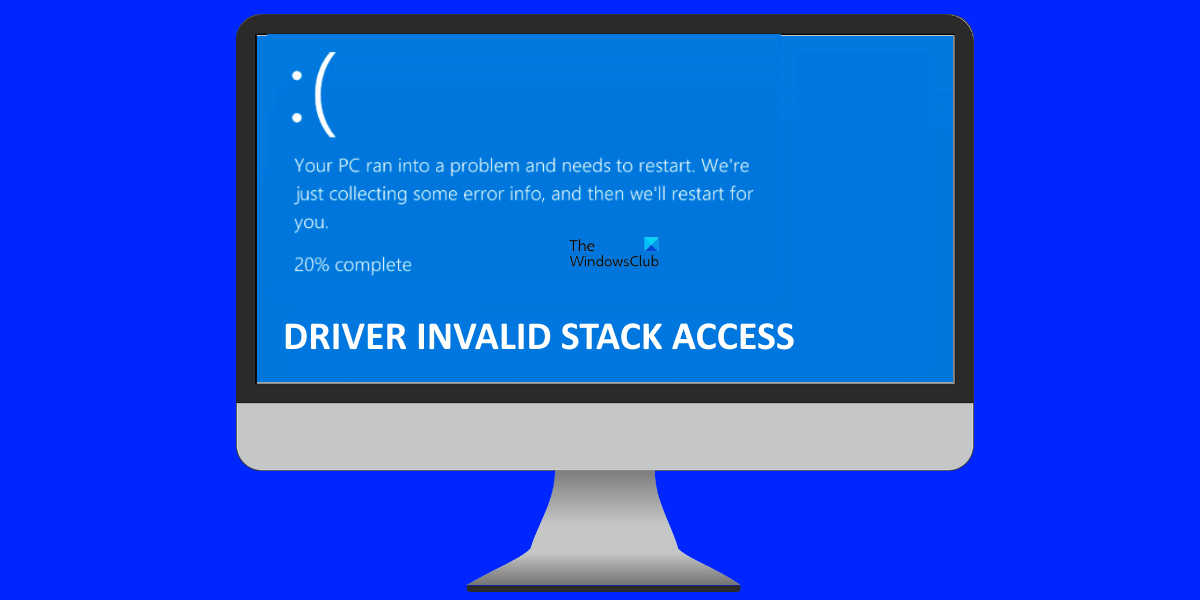DRIVER INVALID STACK ACCESS Blue Screen on Windows 11/10
If you see the DRIVER INVALID STACK ACCESS Blue Screen on your Windows 11/10 computer, the following solutions will help you fix the problem. Let’s see all these fixes in detail.
1] Run Online Blue Screen Troubleshooter
Online Blue Screen Troubleshooter is not a tool you can run on your system. Instead, it provides users with some suggestions to fix the BSOD error based on their feedback. You have to provide some basic information like when you saw the Blue Screen of Death error; after installing an update or while using the system, etc. Based on your input, the troubleshooter will provide possible solutions to fix the error.
2] Disconnect all the devices connected to your system and restart your system
One of the causes of a BSOD error is faulty hardware. If any of the hardware devices connected to your computer is faulty, you may see the Blue Screen error. In this case, the BSOD may occur frequently. If this happens to you, disconnect your devices and restart your computer. Now, see if the error appears again. This will help you know whether the error occurs due to hardware or software issues.
3] Perform a Hardware Clean Boot
You may also see Blue Screen of Death errors if your system’s hardware is not compatible to run Windows 11. You can check this with the help of the PC Health Check Tool. However, the BSOD errors can also occur on supported hardware. This usually happens due to the outdated or corrupted hardware device driver. The Hardware Clean Boot is the best way to identify the device causing the BSOD errors. In this method, you have to disable all the hardware components one by one that are not necessary to run your system. You can do this by disabling the respective device drivers.
4] Disable BIOS Caching or Shadowing
BIOS caching or shadowing is the process of loading ROM into RAM at the time the computer starts. This method makes the execution of commands faster. Sometimes, BIOS caching or shadowing may causes Blue Screen errors. Check if BIOS caching or shadowing is enabled on your system. If you find it enabled, disable it.
5] Repair system files
Corrupted system files also cause BSOD errors. If the problem still persists, some of your system files might have been corrupted. We suggest you run the System File Checker tool to repair the corrupted system files. In addition, you can also run a DISM scan.
6] Uninstall the recently installed programs
As explained earlier in the article, both software and hardware issues can cause Blue Screen errors on a Windows device. It is possible that the program or software that you have installed recently is causing the BSOD error on your system. Uninstall the programs that you have installed recently.
7] Perform a System Restore
System Restore is a tool that saves Registry and system files as restore points. Whenever it detects changes in the system, like the installation of a new program, it creates another restore point. These restore points are used to restore the system when a problem occurs. In other words, System Restore takes your system to the state before the problem started occurring.
When you open the System Restore tool to restore your system, you will see all the restore points created by it along with the date. To restore your system, select that restore point after which the BSOD started occurring on your system. This will fix the problem.
8] Perform an In-place Upgrade
An In-place Upgrade helps repair your system. It is the installation of Windows without uninstalling the currently installed Windows OS. Hence, In-place Upgrade does not erase data. But we recommend you back up all your data before performing the In-palace Upgrade. I hope the solutions provided in this article helped you fix the problem. Read: Fix RDR FILE SYSTEM (Rdbss.sys) Blue Screen on Windows 11/10.
How do I fix a Blue Screen on Windows 11?
There are a lot of causes of Blue Screen errors or stop errors on Windows 11. One of these causes is the unsupported hardware. The system file corruption also causes BSOD errors on Windows 11. You can try some general fixes to resolve the Blue Screen errors on Windows 11, like updating all your drivers, uninstalling the recently installed software, repairing the system image files, etc. If these fixes do not help you, we suggest you perform a System Restore, an In-place Upgrade, or a clean installation of Windows 11.
Why does Blue Screen appear on Windows 11?
Blue Screen appears when Windows detects critical errors that can damage your system. For example, a high CPU temperature, faulty RAM, etc. Apart from faulty hardware, software issues also cause BSOD errors on a Windows device. Blue Screen is an attempt by Windows to protect users’ systems from damage. Every Blue Screen has a unique error code. When a Blue Screen appears, Windows shows the error code along with the error message. You can take a photo of that error for troubleshooting. Windows saves BSOD error logs. You can view Blue Screen error logs in Windows built-in program Event Viewer. Based on the information of the Blue Screen error in Event Viewer, you can troubleshoot it.
Is Blue Screen of Death fixable?
Most of the Blue Screen of Death errors are fixable. You can view the information of the Blue Screen errors in Event Viewer. This information will help you troubleshoot the BSOD errors. In addition, you can also use some general fixes, like repairing the system files, uninstalling third-party software, etc. Microsoft Online Blue Screen Troubleshooter will also help you fix Blue Screen errors. Read next: EXCEPTION_ON_INVALID_FILE Blue Screen.

